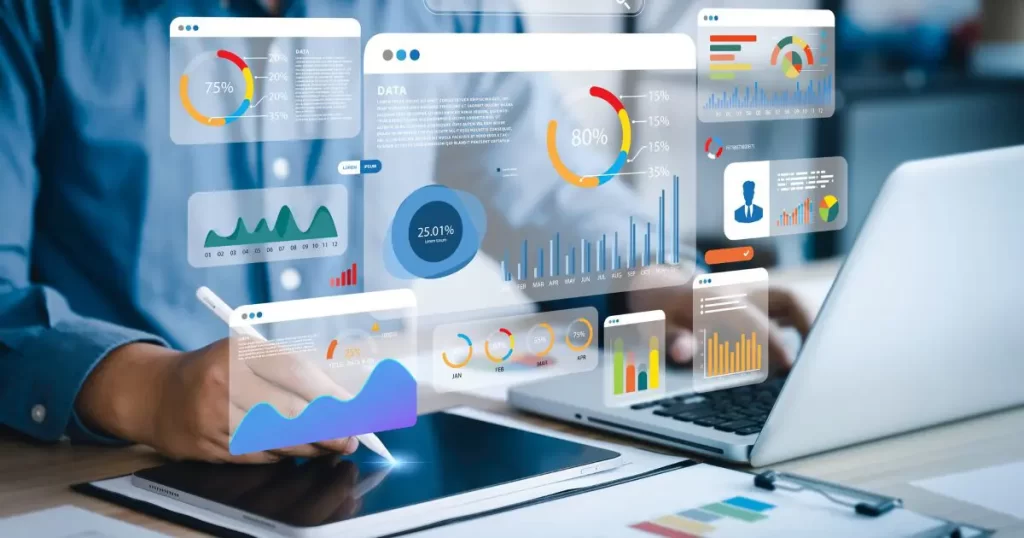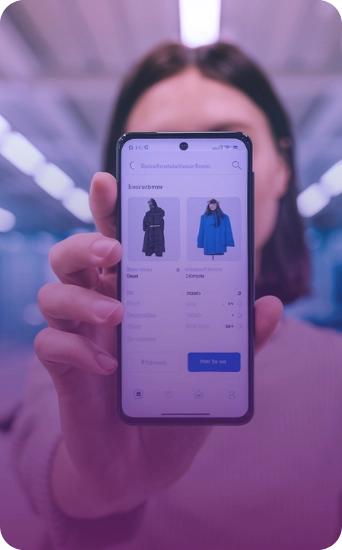The role of the front-end in the growth of mobile commerce

With the popularization of smartphones and the advancement of digital technologies, mobile commerce (aka m-commerce) has become one of the main online shopping channels. On average, 70% of online transactions already take place via mobile devices, according to content published by IT Forum, making it essential for companies to invest in optimized and fluid experiences. In this context, the role of the front-end in the growth of mobile e-commerce is crucial. The importance of the front-end in mobile commerce The front-end is the layer of the application that interacts directly with the user and is responsible for the entire visual and functional experience of a website or application. In m-commerce, where the user's attention is limited and competition is fierce, a well-designed front-end can be the difference between conversion and giving up on the purchase. The main challenges facing the front-end in m-commerce include: Adapting to different devices and resolutions The diversity of mobile devices, with different screen sizes and resolutions, requires responsive and adaptive interfaces. Tools such as media queries in CSS and frameworks such as Bootstrap or Tailwind CSS help to create dynamic layouts that adjust perfectly to any device. Loading speed Speed is a determining factor in m-commerce. Studies show that 53% of users abandon a website if it takes more than three seconds to load. An efficient front-end reduces loading times by using techniques such as image optimization, asynchronous loading of scripts and lazy loading. Intuitive and accessible navigation Usability is essential in m-commerce. Navigation elements such as simplified menus, appropriately sized buttons and straightforward checkout flows ensure an intuitive experience. In addition, following accessibility practices, such as adequate contrast and keyboard navigation, broadens the audience's reach. User experience: the engine of growth The front-end in m-commerce is not just an aesthetic issue; it is the engine behind a positive shopping experience. Here's how it drives growth: Advanced interactivity With the use of modern technologies, such as JavaScript and frameworks like React or Vue.js, it's possible to create highly interactive interfaces that engage the user. For example, product carousels, dynamic filters and personalized suggestions make the experience more enjoyable. Integration with mobile functionalities The m-commerce front-end can take advantage of native device features, such as geolocation, push notifications and biometric authentication, to offer personalized and secure experiences. Data-driven design Analysis tools such as Google Analytics and Hotjar help to understand user behavior. Based on this data, the front-end can be continually adjusted to meet the preferences of the target audience. Good practices for an efficient mobile commerce front-end To ensure a positive impact on m-commerce, the front-end should follow some good practices: Mobile-first design Adopting a mobile-first approach means designing with mobile devices in mind first. This guarantees light, functional and intuitive interfaces, prioritizing the essential elements. Loading time Loading speed is fundamental to success in m-commerce. Use techniques such as image compression, use of CDN (Content Delivery Network) and minimizing CSS and JavaScript files. In addition, implement strategies such as lazy loading to load only the visible elements and improve the overall performance of the page. Use of PWA (Progressive Web Apps) PWAs combine the best features of websites and native applications. They offer fast loading, can work offline and are installable on the device, providing an app-like experience. Continuous testing and iteration Regular usability testing is essential. Tools such as BrowserStack and Lighthouse allow you to simulate different conditions of use and evaluate the performance of the interface. Focus on SEO for mobile A well-structured front-end must take into account good SEO practices for mobile devices, such as friendly URLs, correct use of tags and reduced response times. This helps improve search engine positioning, attracting more qualified traffic. The growth of mobile commerce is directly linked to the quality of the user experience offered, and the front-end plays a strategic role in this process. Companies that invest in responsive, interactive and optimized interfaces are better prepared to win over and retain customers in the mobile environment. By aligning technology, design and usability, the front-end not only facilitates use, but also creates emotional connections that turn visitors into loyal consumers. In the competitive m-commerce market, offering an impeccable experience is not just a differentiator, it's a necessity.
How can BI forecasts change the e-commerce game?

BI has established itself as an essential tool for the success of e-commerce, as it provides valuable insights based on data. Revolutionizing e-commerce with forecasts that can change the game in countless critical areas, the technology improves decision-making, operational efficiency and, above all, the customer experience. Referred to as "business intelligence", the concept of BI brings together theories, methodologies and processes that, combined with technology, make it possible to collect and convert a significant amount of data into structured information, with the aim of benefiting the company and its decisions, putting it ahead of the competition. Offering a broad view of the business and the market scenario, data identifies trends and detects flaws in order to apply preventive rather than corrective measures. Therefore, interpreting and analyzing the information mapped out through BI support allows action to be taken in a timely manner. Today, stock-outs, for example, are one of the biggest challenges for e-commerce, resulting in lost sales and, consequently, customer dissatisfaction. In this case, BI anticipates possible stock-outs by analyzing history, seasonal trends and inventory data. Even the most advanced BI tools offer real-time visibility of stock, thus alerting managers to the need to restock before products run out. The tool also makes it easier to monitor operational KPIs for customer service and logistics, allowing for detailed analysis of metrics such as response and delivery times, problem resolution rates, among others. This is crucial for maintaining efficiency and customer satisfaction, as it identifies areas for improvement and implements corrective actions quickly. Product portfolio analysis, using the ABC classification, helps to map out which items are most important to the business. In other words, products on the A curve are the most valuable, contributing the most revenue, while products on the B and C curves have less impact. In this example, Business Intelligence offers insights into the sales performance, profit margin and stock turnover of each product, making portfolio management more strategic. The tool even simplifies inventory management across multiple marketplace channels, as it integrates data from different platforms. The technology provides a unified view of the warehouse, which makes it possible to optimize the distribution of products according to demand and also identifies which products perform best on each channel. According to the survey How Retailers Use Innovation to Gain an Edge, by the Boston Consulting Group (BCG) and the World Retail Congress (WRC), retail investment in technology is expected to increase by 20% in Latin America by 2027. After all, companies that keep up with behavioral changes and consumer preferences achieve a higher return on investment (ROI). Also according to the study, worldwide, the retailers that invest the most in innovation - an average of 13% - achieve an ROI of 21%, while those that invest the least - only 3% - have an ROI of 9%. Continuous innovation is therefore essential for the increasingly evident dynamism of e-commerce. BI contributes directly to the customer conversion rate, promoting greater loyalty and satisfaction. It's no coincidence that the tool is capable of determining the cards in the game, and it polishes e-commerce strategies for solid business growth. *Content signed by Alexandre Assis: Chief Technology Officer (CTO) at Social Digital Commerce since 2022 and was voted the best technology professional by Abradi in 2021. He has been managing IT teams and projects with a focus on technology and e-commerce for over 17 years. Contributing to the delivery of more than 150 e-commerce projects that encompass B2C, B2B, B2E, D2C, omnichannel and Dark Store models, the executive has solid knowledge of the entire e-commerce management process, LGPD, governance processes and compliance risk.
Business Intelligence in Brazilian e-commerce

Business Intelligence (BI) has proved to be an essential tool for the sustainability and growth of e-commerce in Brazil, especially in the face of fierce competition and the need for an efficient operation. Responsible for collecting, analyzing, monitoring and sharing a large volume of data, the technology makes it possible to draw up relevant strategies for the sector and, above all, more assertive decision-making, since analysts base their decisions on facts rather than assumptions. With the dynamism and movement of the digital universe, Business Intelligence is gaining more and more ground in the market as a facilitator of the daily demands of the business environment. The technology provides an efficient understanding of leads, assertive segmentation and optimization of e-commerce operational management. BI can even be used to integrate logistics and customer service, thus enabling effective operational management. Today, the implementation of BI solutions has stood out as a competitive differentiator even in terms of the consumer experience, as the tool improves on-page contact with consumers. In short, Business Intelligence helps to collect reliable data, which guarantees assertiveness in decision-making. This is precisely why companies are increasingly opting to use technological tools and methodologies such as BI. No wonder, according to the study on the Brazilian Software Market 2022, the software sector grew by 19.5% in 2021. But how is BI saving Brazilian e-commerce millions? Among the main technological aspects are data collection and integration. These platforms are able to integrate information from multiple sources, including websites, mobile apps, ERP systems, CRM, social networks and marketing platforms, for example. With this, machine learning and artificial intelligence algorithms are applied, with the aim of predicting market trends, consumer behaviour and stock optimization in an advanced way. There are also data mining techniques capable of pinpointing hidden patterns and valuable insights that can influence strategic decisions. When it comes to visualizing this data, there are tools such as Power BI, Tableau and Qlik, which allow you to create interactive and personalized dashboards, thus facilitating the analysis and interpretation of this information. It is even possible to generate automated reports in real time to help make decisions quickly and concisely, as well as to monitor the performance of sales, logistics and, respectively, customer service, enabling immediate corrective action. Still answering this article's question, from a business point of view, BI reduces costs by optimizing stocks and providing greater operational efficiency. Predictive analysis maintains optimal storage levels, avoiding excess or lack of products. In addition, the technology identifies possible operational bottlenecks, implementing continuous improvements capable of minimizing waste. In return, there is an increase in revenue, after all, the tool personalizes the customer experience, offering relevant products and promotions, which contributes to the conversion rate and loyalty, while at the same time evaluating the competition and consumer behaviour in real time. This enables a dynamic pricing strategy and, consequently, maximizes profit margins. And finally, BI anticipates market trends, which makes constant and immediate changes possible. This competitive advantage is essential, especially when investing in new technologies and technology-based methodologies that put you ahead of the competition. Business Intelligence therefore enhances e-commerce strategies. Using it exponentially in the business provides greater opportunities, new insights and assertive decisions. Remember: smart businesses will always be those that think strategically. Today, adopting a solid Business Intelligence strategy in e-commerce is the certainty that new and valuable sales opportunities will arise.
Up-to-date technology for exceptional e-commerce results and solutions

When it comes to online shopping, it's crucial that the technology is modern in order to deliver more quality to the market and to the customer. This is even more the case today because of how the public views technology and the internet. According to a survey published by DataReportal at the beginning of 2023, the influence that the internet has on Brazilians' lives is 84.4% (the global average is 64.4%), totaling 9h32min on the internet. But what does this mean for the e-commerce and mobile markets? Basically everything, because 97.1% of users make purchases using their cell phones. This implies a need to adapt to cutting-edge technology in order to provide users with a safe experience and exceptional solutions. Check out the full article on the E-commerce Brasil website: https://bit.ly/3U2hVc4
Social Digital Commerce advances in Latin America's e-commerce market

Social Digital Commerce, a company that has been developing e-commerce businesses for seven years, is moving ahead with its expansion plan for Latin America after structuring its market in two other continents: Europe and Asia. With operations in the United States, Portugal and China, the company's goal is to hire more than 400 new professionals by the beginning of 2024 and expand its presence in countries such as Mexico, Chile, Argentina and Colombia. Social Digital Commerce offers solutions for companies that want to sell more in the digital environment, multiply sales, expand into the international market or do business beyond digital. In this sense, four service hubs encompass all the solutions for clients wishing to leverage their business, Digital Management being one front that provides the most technological and innovative solutions for digital sales. Read the full article on the E-commerce Brasil website: https://www.ecommercebrasil.com.br/noticias/social-digital-commerce-avanca-america-latina
Podcast Entre Amigos - E-commerce Brasil and Social Unlimited Digital Commerce | The challenge of Flagships in times of Marketplace.

With the massive penetration of Marketplaces in digital shopping, Flagship stores have been struggling to maintain their relevance in the market. In today's episode, we'll discuss which strategies can be used to build public loyalty and boost your store sales. 1) For what reasons should companies consider implementing flagships? 2) What do you think is the reason why people choose to shop on Marketplaces rather than Flagships? 3) What strategies can flagships use to attract the public and overcome the public's preference for Marketplaces? 4) What kind of role can offline stores play in building loyalty and how can they use these spaces to promote their online stores? 5) What can flagships do better than marketplaces to attract consumers? Enjoy the moment and play the podcast episode now, directly on Spotify! Names of the participants:Henrique Tardeli - Marketing Director - Social Unlimited Digital Commerce Rafael Scaramucci - Country Manager - Social Unlimited Digital Commerce Douglas Araújo - Head of E-commerce - Social Unlimited Digital Commerce Alexandre Ieva - Host - E-Commerce Brasil Follow our networks or get in touch:










